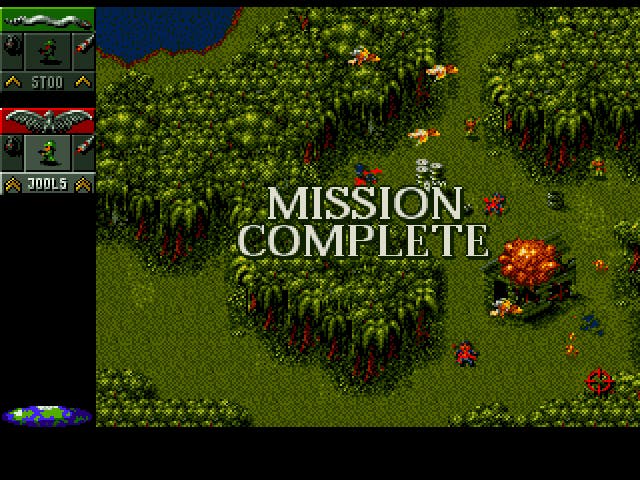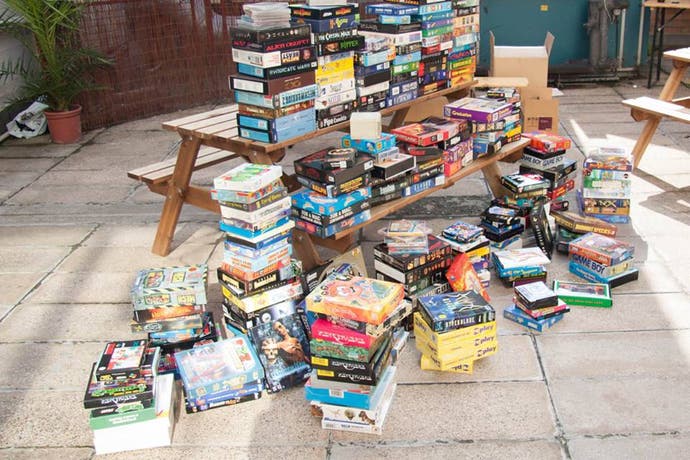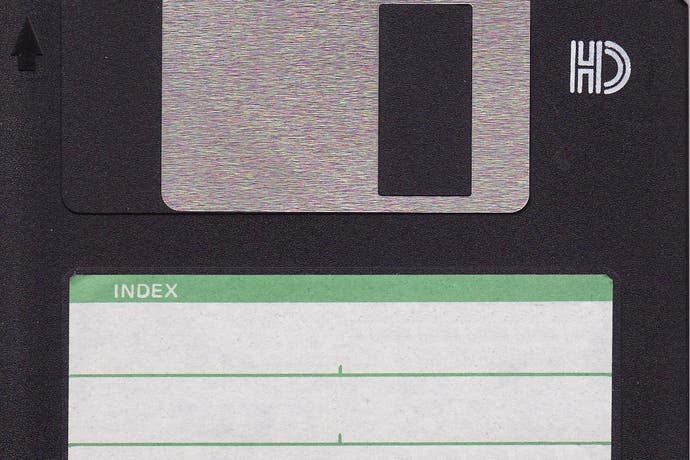Your Amiga games are likely dying
Damp attics and insidious 'bit rot' are destroying floppy disks. Who is saving them?
The Amiga 500 came out just over 30 years ago, seeing as many as 6000 games released across its lifespan and that of its two immediate successors, the Amiga 600 and Amiga 1200. But if you were to dig out your old Amiga from the loft and try to load up Cannon Fodder, Pinball Fantasies, Zool or any other of the machine's classic titles, there's a very good chance they won't work.
Bar a few late CD releases for the Amiga 1200, almost all Amiga games came on 3.5-inch floppy disks - a notoriously unreliable medium. Inside the hard plastic case is a floppy, round, plastic disc with a magnetic coating. The binary game code is stored on this disc in the form of opposite magnetic polarities - one polarity for 1 and the other for 0. The trouble with storing data using magnetic polarities, though, is that it's very easy to de-magnetise the disk. If you ever left your floppies too close to a strong magnetic source, like an old CRT monitor, you'll no doubt be familiar with the problem.
Even without exposure to a magnet, the data on floppy disks will de-magnetise over time - a phenomenon called 'bit rot'. The truth is that no one knows for sure how long floppy disks can actually last. "They don't have a shelf-life, as such," says James Newman of the National Videogame Arcade (NVA) in Nottingham. "There are so many variables, from the quality of the original media through to how often they were used and how they've subsequently been stored. Variations of temperature and humidity can affect the adhesives that glue the magnetic particles to the disk itself, and you can get oxidisation - there's a lot that can go wrong! The simple truth is that these media weren't designed with the kind of longevity we're now expecting in mind - certainly it wasn't anticipated that they'd need to last 30 years or more..."
And Christian Bartsch of the Software Preservation Society (SPS) has bad news for people with a stash of Amiga games in their loft. "If a disk was stored under perfect conditions it is likely it still works today. But if it was banned to the attic, with hot summers and cold winters, chances are the coating has already been damaged. High humidity might have caused mould. Our recommendation is: get the data off these floppies sooner than later."
The urgent need for preservation
Amiga disks are decaying, and with every year that passes, originals are getting more difficult to find. "Generally, the further we get from the release date, the harder it is to find what you're looking for," says Ken McAllister of the Learning Games Initiative Research Archive (LGIRA). It's getting more expensive, too, with eBay prices skyrocketing.
And the sad fact is that very few seem to care little about preserving old games for future generations. "Every book, record or film is archived by national libraries," says Bartsch. "In many cases it's an obligation. But with games it's not."
The preservation of Amiga games is therefore down to a scattered group of amateurs. But if they're able to find original Amiga disks in good working order, what do they do with them next? It turns out that the groups I spoke to have quite varied approaches when it comes to game preservation.

For Bartsch at the SPS, it's all about obtaining the original data in the best possible condition. "Games usually had protection, so what's in circulation online is cracked material, games that were defaced with digital graffiti and changes (such as edits to game mechanics and cheating stuff). Also, the original high scores, which programmers often filled with the names of team members, might be changed on a crack. It's like wanting to see the Mona Lisa, but then just looking at some defaced print."
"Preservation of a book is (relatively) easy. Find a climate controlled room with low oxygen levels and controlled humidity, make sure the book is free of mould, check acidity, etc., and then that's it. You might even scan it or photograph it. For software it's completely different. Just imagine this very book suddenly is encrypted and can only be decrypted if you know how to decrypt it. And then add the challenge that the decoding will break if there's only a single character that is unreadable. Plus it's degrading very quickly."
Bartsch and his colleagues focus on creating perfect digital clones of floppy disks, then save them as image files for long-term storage. But because original Amiga hardware is also degrading, they developed a modern software tool called KryoFlux to help pull the data off old floppies, a tool that has been picked up by many others in the community. "We never planned to become a tech provider, but it seems like what we created has become the de facto standard for software preservation," says Christian.
The society's emphasis is on preserving the original data exactly - data protection and all. "Our files are bit-perfect representations of the original media with all anomalies, including copy protection. We can guarantee integrity and authenticity, something that's very important, but only implemented by few."
Games behind bars
But there's one problem: members of the public can't play the Amiga games stored by the SPS. "We're not allowed to put them up for download," says Bartsch. "This is the typical problem of preservation versus copyright. Most of the companies are long gone, but usually there is someone who still owns the IP. Until politics decides what to do with so-called abandoned or orphaned works, we can't do much with it."
"We can only give data to other institutions and, this is the only exception, to contributors. Whoever dumps a rare game and sends it to us will of course get the analysed file in return." But Bartsch notes that the society can't control what happens to the files once they give them back to the people who sent the original disks. Although it's technically illegal, many contributors simply upload the image files to the internet. "To our understanding about 80 per cent of the images we have created are in circulation."

In fact, what the SPS is doing could also be considered problematic, explains Barsch: "In most parts of Europe the only thing games museums or archives are allowed to do is put up the media on their shelf and let it rot. Even the pure transfer of the data off the disk and into an image file might be regarded as piracy." But seeing the pressing need to preserve decaying Amiga files, the SPS decided it had to press on. "We felt we could not wait, so we looked at this from the legal side of things and made sure that we'd do it in a way where we can continue doing so, and leave the rest to the community." So far, no one seems to have had a problem with the SPS copying old games. "In general, copyright holders are pretty happy with what we do. We haven't had a single complaint in now more than 16 years," says Bartsch. In fact, some companies have approached the SPS to ask whether they can use KryoFlux to preserve their old data.
Context is key
For James Newman at the NVA, however, preservation is not just about copying data perfectly - he also sees a role for emulation and carefully recording the context that a game was played in. "There are lots of different aspects to game preservation. For some, preserving the bitstream - the data - is the focus. So, getting data off those fragile disks and migrating them to multiple backup devices is the objective. Obviously, we then have to work out what to do with them, which very often means emulation as, while there are lots of Amigas around at the moment, they're not going to last forever. So, for long-term access, emulation looks like the best bet at the moment."
"But that's not the only thing that could constitute game preservation. Being able to play a game at some point in the future might be useful and fun but it doesn't necessarily tell you what the game 'meant' when it was released or how it was played - and how that play might have changed over time as players worked out new things the game could do or new things they could do with the game. So, there's another approach to game preservation that is focused on documentation and context. This could involve oral histories of developers talking about their work, or players and fans discussing the game, or reviews, forum posts, FAQs and walkthroughs, Let's Play videos, etc. All of this helps us understand the game in its historical and cultural contexts, which you wouldn't get from playing it yourself."

The National Videogame Arcade was created, in Newman's words, as "part museum and gallery, part visitor attraction, and part education project", and its ethos is to think about video games as cultural heritage: "important parts of our shared history", as Newman puts it. As such, the organisation puts a lot of effort into creating a rolling programme of exhibitions that explore games in the context of the time they were released. Importantly, many of the games are playable. "We're really interested in designing and making new ways to look at games and new techniques to reveal what's interesting about them, how they work, how they're played. So, we spend a lot of time collecting games which we make playable in our galleries but we also put a lot of our efforts into designing exhibitions and exhibits that offer insight into a game's design or the systems and algorithms that underpin it - the sorts of things that are sometimes difficult to reveal by playing a game."
LGIRA similarly seeks to put historic games in the hands of players. "Our principle preservation technique is what we call 'preservation through use'." says Ken McAllister. "In other words, giving as many people as possible experiences and memories of playing actual games." Founded in 1999 in the United States, the archive welcomes game researchers to browse its collection of more than 250,000 items stored at the University of Arizona. These range from Tomb Raider t-shirts to Prima strategy guides and, of course, "a decent collection of Amiga hardware and software", says McAllister. He notes that Balance of Power, a Cold War simulation, and Kampfgruppe, a Second World War tactical game, are the most requested Amiga games in the archive.
The Amiga lives on... mostly
The good news when it comes to preserving Amiga games is that the machine's huge sales mean there are still plenty of games out there, even if they're gradually succumbing to bit rot. Perhaps more importantly, the format still has a lot of fans. "There's a really large and active international community of Amiga enthusiasts today who are dedicated to celebrating the platform and keeping it alive," says Newman. "It's always easier dealing with a machine that had a big install base and is actively collected and worked on by fans." The real problem when it comes to games preservation, he says, is finding software and hardware for less-loved computers. "If you compare the Amiga with something like the Dragon 32 or even a contemporary and competitor computer like the Atari ST, the situation is quite different."

But regardless of format, the legal barriers surrounding the copying of game files still hound the efforts of groups that are desperate to preserve video-game history. James is part of an attempt to cut these legal ties: "A lot of the legislation and restrictions put in place to counter software piracy also affect preservation projects. There's a lot of lobbying taking place at the moment across Europe through organisations like the European Federation of Games Archives and Museums Projects, of which the NVA is a member, to try to get the situation addressed."
Even though groups like the SPS, NVA and LGIRA are doing their best to preserve Amiga software, it will be nigh-on impossible to save everything. For Bartsch and the SPS, it's a race against time: "Sometime in the future when politicians have understood [regarding the preservation of] orphaned works, it'll be too late for some titles." Newman adds that the scale of the task is daunting: "The sheer amount of software, of games, of demos, means that it's inevitable that some things will be lost."
Still, Newman is more concerned about losing the digital-only titles being released now than the Amiga games of old. "Floppy disks might be unreliable, but the challenges of dealing with games where there is no physical medium are in a different league altogether. We're going to need to think creatively about how we interpret and document these so-called 'born digital' materials."









